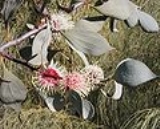
Hakea petiolaris
Encyclopedia
Hakea petiolaris, commonly known as the Sea-urchin Hakea, is a shrub or small tree which is endemic to the south west
of Western Australia
in a range between Wongan Hills
and Hyden
usually associated with granite outcrops and hills.
Hakea petiolaris was first described by Carl Meissner
in 1845, after being collected near York by Ludwig Preiss.
It has three subspecies
.
The main characteristics of the subspecies are in the flower colouring :
Hakea petiolaris grows as a tree or shrub up to 9 metres (30 ft) in height. The leaves have a distinctive pale-grey colour and are 5.5 to 15 cm long and 2.5 to 6 cm wide. Flowering occurs in autumn and winter (March to July), the inflorescence
s appearing on small branches or forks of branches. They are roughly spherical and contain 120 to 200 individual flowers. The pistils are 1.4 to 1.8 cm long and white or cream in colour. The perianth ranges from pink to purple. Flowering is followed by woody seed capsules which are 2 to 3.5 cm long and 1 to 2 cm wide. Each splits into valves and releases 2 dark brown or black winged seeds.
Response to fire is varied, with some forms resprouting from a lignotuber and others being kiled and regenerating from seed.
Southwest Australia
Southwest Australia is a biodiversity hotspot that includes the Mediterranean forests, woodlands, and scrub ecoregions of Western Australia. The region has a wet-winter, dry-summer Mediterranean climate, one of five such regions in the world...
of Western Australia
Western Australia
Western Australia is a state of Australia, occupying the entire western third of the Australian continent. It is bounded by the Indian Ocean to the north and west, the Great Australian Bight and Indian Ocean to the south, the Northern Territory to the north-east and South Australia to the south-east...
in a range between Wongan Hills
Wongan Hills, Western Australia
Wongan Hills is a town in the Shire of Wongan-Ballidu, in the Wheatbelt region of Western Australia. The town is approximately 182 km north of the State capital Perth, at an altitude of 286 metres....
and Hyden
Hyden, Western Australia
The town of Hyden is located 339 km east of Perth, Western Australia in the Shire of Kondinin. Hyden is home to Wave Rock and Mulka's Cave, both popular local tourist attractions....
usually associated with granite outcrops and hills.
Hakea petiolaris was first described by Carl Meissner
Carl Meissner
Carl Daniel Friedrich Meissner was a Swiss botanist.Born in Bern, Switzerland on 1 November 1800, he was christened Meisner but later changed the spelling of his name to Meissner. For most of his 40 year career he was Professor of Botany at University of Basel...
in 1845, after being collected near York by Ludwig Preiss.
It has three subspecies
Subspecies
Subspecies in biological classification, is either a taxonomic rank subordinate to species, ora taxonomic unit in that rank . A subspecies cannot be recognized in isolation: a species will either be recognized as having no subspecies at all or two or more, never just one...
.
The main characteristics of the subspecies are in the flower colouring :
- subsp. petiolaris - the perianth darkens to mauve and then pinkish red; it has the smallest leaves. It is the variety that is found in the JarrahJarrahEucalyptus marginata is one of the most common species of Eucalyptus tree in the southwest of Western Australia. The tree and the wood are usually referred to by the Aboriginal name Jarrah...
forest. - subsp. trichophylla - the perianth darkens to mauve and then maroon: it is the most common subspecies in cultivation.
- subsp. angusta - the perianth darkens to mauve and then pinkish mauve.
Hakea petiolaris grows as a tree or shrub up to 9 metres (30 ft) in height. The leaves have a distinctive pale-grey colour and are 5.5 to 15 cm long and 2.5 to 6 cm wide. Flowering occurs in autumn and winter (March to July), the inflorescence
Inflorescence
An inflorescence is a group or cluster of flowers arranged on a stem that is composed of a main branch or a complicated arrangement of branches. Strictly, it is the part of the shoot of seed plants where flowers are formed and which is accordingly modified...
s appearing on small branches or forks of branches. They are roughly spherical and contain 120 to 200 individual flowers. The pistils are 1.4 to 1.8 cm long and white or cream in colour. The perianth ranges from pink to purple. Flowering is followed by woody seed capsules which are 2 to 3.5 cm long and 1 to 2 cm wide. Each splits into valves and releases 2 dark brown or black winged seeds.
Response to fire is varied, with some forms resprouting from a lignotuber and others being kiled and regenerating from seed.
Further reading
- Young, Jennifer (2000) Hakeas of Western Australia : botanical districts of Irwin and Darling - the Northern Sandplains and the South-west Forest West Perth, W.A.. ISBN 0958577803

